If your neck pain extends to your shoulder and arms, it is called Cervical Radiculopathy. It is caused by a “pinched nerve” in your neck.
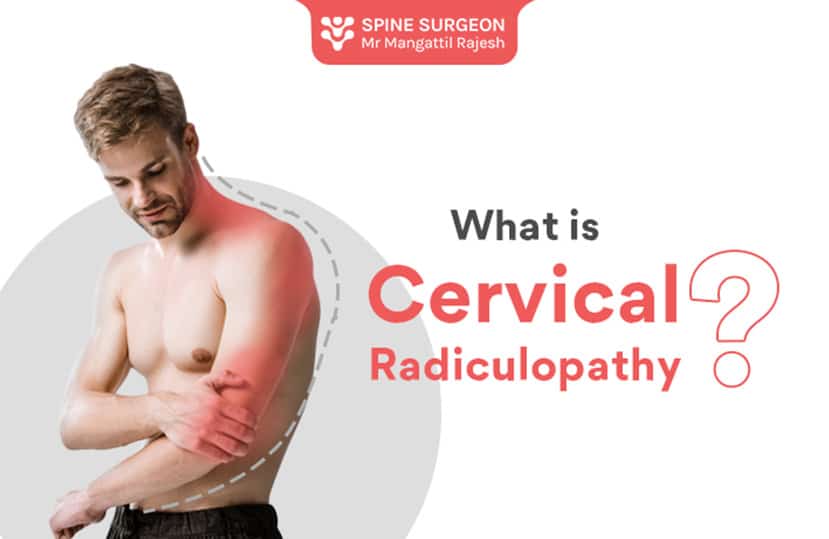
The nerve can be ‘pinched’ in 2 common situations:
1) Prolapsed Disc or Bulging Disc or Herniated Disc
– All these terms mean the same! Here the disc in your neck pops out to irritate the nerves coming out of the spine.
2) Foraminal Stenosis
– As the spinal nerve comes out through the tiny holes on the side of the spine, it gets trapped due to the narrowing of the hole.
In any case, the spinal nerves coming out of your neck gets irritated and sends pain signals to your brain. Both young people and older people are at risk of Cervical Radiculopathy.
The risk for Cervical Radiculopathy tends to increase with your age. Young people are at risk from very sudden and strenuous activities that are put high levels of stress on their cervical spine, such as wrestling or weight-lifting. However, the risk peaks in people who are in their 40s and 50s.
What causes Cervical Radiculopathy?
1) Prolapsed Disc or Bulging Disc or Herniated Disc:
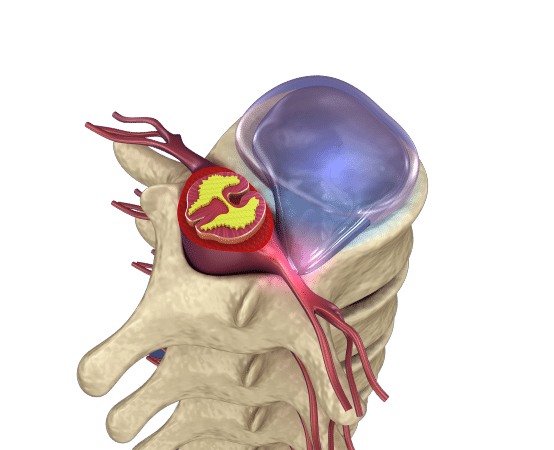
A herniated disc most commonly occurs in younger and active people. Injury to your neck, strenous activity and repetitive strain injury to your neck can cause a herniated disc.
Herniated Disc is also known as Disc Prolapse and is the most common cause of Cervical Radiculopathy. The inner material of soft cushions (discs) between the bones leaks out and causes irritation or compression of the nerve (red color) coming out of the exit canals in the spine of your neck.
2) Foraminal Stenosis:
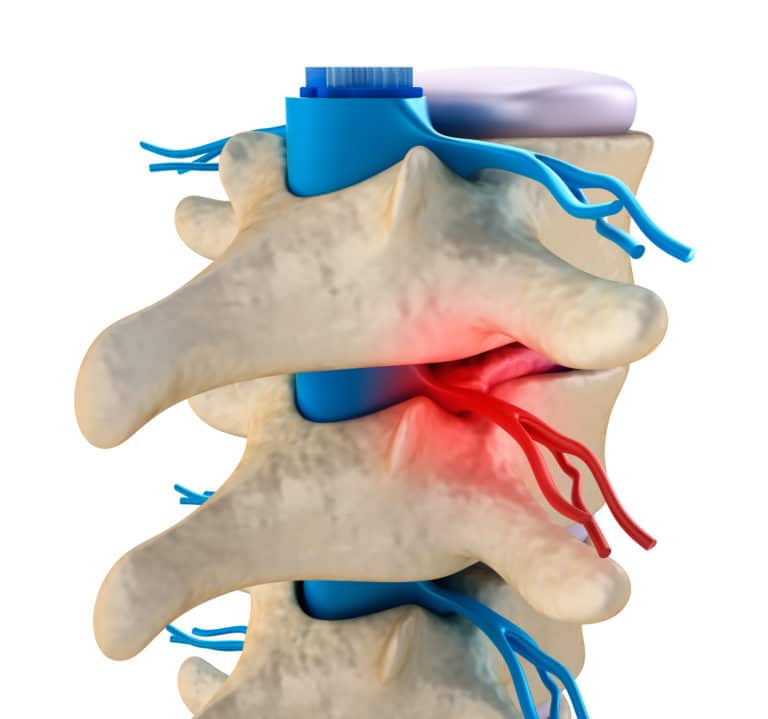
There are small bony holes in your spine through which the spinal nerve comes out. These are called foramen. As we grow older, wear and tear changes causes narrowing of these holes and this causes pinching of the spinal nerve. The ‘pinched nerve’ causes pain, tingling, numbness and weakness of your arm.
If these holes are blocked, the spinal nerve gets trapped. This condition is called Foraminal stenosis.
Common Causes are:
– Cervical osteoarthritis
– Cervical degenerative disc disease
– Bony spurs called osteophytes
Why is Cervical Radiculopathy so painful and serious?
Cervical Radiculopathy is a very painful condition.
Chemical inflammation causes severe pain:
When your herniated disc ruptures, it releases a chemical irritant that leaks out and inflames the spinal nerves that come out of the spinal canal in the neck to supply your arms. The chemical inflammation stimulates the pain fibres along the spinal nerve and causes sharp, burning and shooting pains along your affected arm. You will feel like a rope or string of pain from your neck to your shoulders, arms and fingers.
Direct Compression of the Spinal Nerve:
If the herniated disc bulge is very large and does not rupture, there is no chemical to irritate the spinal nerve. In this case the spinal nerve is compressed or pinched by the large sized prolapsed disc and stops the signals going to the arm from your brain. You will not feel the sensation in your arm. If the compression continues, you will find that your arm and fingers go weak and cannot perform daily tasks.
Which fingers are commonly affected by Cervical Radiculopathy?
This is as simple as counting on your fingers!
Any finger can be affected by Cervical Radiculopathy with pain and numbness. The finger affected gives a clue as to which nerve is ‘pinched’. So it is simple to work out which disc causes the radiculopathy condition.
C5 Radiculopathy – Neck pain down to your shoulder or numbness
C6 Radiculopathy – Neck pain down to your Thumb and Index finger or numbness
C7 Radiculopathy – Neck pain down to your Middle finger or numbness
C8 Radiculopathy – Neck pain down to your Ring and little finger or numbness
What are the common symptoms of Cervical Radiculopathy?
How long does it take to heal from Cervical Radiculopathy?
Healing from cervical radiculopathy begins the moment you start the simple methods outlined below. This includes reduced physical activity, ice or heat application, pain medications, stretches and improvement in your posture. Depending on the extent of the ruptured disc and the size of the prolapsed disc, the symptoms of pain and numbness may take longer to subside. You may require physiotherapy exercises from a physical therapist under supervision and The pain usually settles in about 80% of patients and it takes 6 to 8 weeks.
What happens if the pain does not subside in 6-8 weeks?
If the pain does not subside in 6 to 8 weeks, you may need steroid injections right at the point of spinal nerve root compression in the neck under sedation after admission to a hospital to reduce the inflammation. The pain and inflammation from cervical radiculopathy will subside with steroid injection in about 2 to 4 months.
If there is numbness or weakness of the arm and fingers and if the MRI scan shows a large disc that is pressing on a spinal nerve in cervical radiculopathy, then surgical removal of the prolapsed disc will be necessary.
What makes Cervical Radiculopathy worse?
Cervical radiculopathy presents with pain and stiffness in the neck along with the pain radiating down your shoulders, arms and fingers. Adequate rest, medications and mild stretches will certainly help to improve the pain in the neck and arm.
However if that is increase in your activity levels like continuing to work, sudden jerky movements and having a poor posture, the symptoms of cervical radiculopathy will worsen.
Initially the symptoms will be of a milder nature with pain in the neck and down your arm. But in the later stages there be tingling of your arm and fingers along with numbness of your arm. At this stage, you may not be able to feel or have any sensation in your arm and fingers. Occasionally this may lead to weakness of your arm and fingers leading to paralysis of your arm.
What can you not do with a herniated disc in your neck?
With a herniated disc in your neck you should avoid any exercises that will cause a jerk or a sudden jolt to your neck. This may be activities like weightlifting, running, driving, twisting and turning. This can possibly irritate or squeeze the herniated (bulging) disc.
Other day-to-day activities of daily living that you can not do are – sitting too much, hoovering the floor, leaning forward and washing your dishes, doing the laundry, gardening and any strenous exercises.
It is recommended that you avoid your gym until you are pain free for at least 10 days.
How do you fix Cervical Radiculopathy?
Initial treatment for Cervical radiculopathy is to reduce normal physical activity, apply heat or ice to the inflamed area, pain medication, mild stretches and improvement in your posture. Cervical epidural steroid injection may be necessary if the symptoms do not subside.
Manual chiropractic manipulation is not recommended in the initial painful phase of Cervical radiculopathy particularly when the arm pain is associated with neck pain. Spinal manipulation may be useful if there is only neck pain but no arm pain. Neck pain with arm pain suggests that your spinal nerve is trapped and a spinal manipulation may stretch your trapped spinal nerve causing severe damage to the nerve. The spinal nerve may not recover leading to loss of function of your arm.
Cervical traction is not recommended for neck and arm pain in Cervical radiculopathy. There is enough evidence in the literature to suggest that benefits from cervical traction therapy are short lived and it is not necessary. Most recognised centres in London do not offer this therapy as they are not beneficial to patients in the long term.
Can a chiropractor fix a herniated disc in your neck?
Chiropractors can help fix a herniated disc or a bulging disc if there is neck pain with no arm pain. Most herniated or bulging discs cause just axial neck pain alone. But neck and arm pain is caused by the disc trapping or pinching the spinal nerve.
Neck pain with arm is associated with symptoms of pain radiating to your arm, sensation of pins and needles, tingling, numbness of your fingers or weakness of your arm, then it is more than a disc prolapse.
These neck pain and arm symptoms indicate that the disc prolapse or disc herniation actually traps or pinches the spinal nerve supplying your arm. Chiropractic manipulations may exacerbate these symptoms in a prolapsed or a herniated disc situation.
What is the initial best treatment for Cervical radiculopathy?
Non-operative treatment for Cervical Radiculopathy is supported by scientific evidence as they show that cervical radiculopathy symptoms improves with time without the need for surgery. There is evidence to prove in patients who had non-operative treatment for cervical radiculopathy, their MRI scans showed that disc hernations had reduced on repeat MRI scans. Non-operative treatment also includes, physical therapy (physiotherapy) and spine injections.
Here are 5 simple steps that are useful to manage Cervical Radiculopathy at Home

Can sleeping wrong cause 'pinched nerve' in the neck?
Sleeping with your neck in an awkward position can cause the tiny holes through which the spinal nerve nerve comes out to reduce in size and trap the spinal nerve. These narrowed holes called foramen causes a pinched nerve with neck and arm pain. The arm pain travels down to your fingers with tingling and numbness.
This can be avoided by sleeping in the correct position on your back and on your side as shown below.

What simple exercises can I do for Cervical radiculopathy?
There are six simple exercises that you can do for cervical radiculopathy. These six exercises are very easy to do and will relieve your neck and arm been quickly. Here is the exercise for Cervical Radiculopathy link:
1) Foward Bend
2) Backward Bend
3) Side Bend
4) Side to Side Turn
5) Rotation of your Neck
6) Pull your Neck back and Hold
First sit in a quiet place in a very relaxed position. Look straight ahead and do these exercises in a very relaxed manner. Feel the stretch on your muscles, ligaments and tissues at the front and back of your neck. Do this very slowly.
Hold the stretch for at least 5 to 10 seconds. Breathe in and breathe out three times. Bring your head back gently to look straight ahead and relax. Your Neck and arm pain will feel a lot better.

What is the best pain reliever for a pinched nerve in neck?
The best pain reliever for nerve pain or a pinched nerve in the neck is Gabapentin and Pregabalin. Though these two medications are very good in controlling neck and arm pain, these medications work on your brain and come with significant side-effects. Therefore these medications are not described as a first-line drug even by specialists.
To start with, nerve pain and pinched nerve in the neck is usually managed with:
1) Paracetamol
2) Ibuprofen
3) Naproxen
4) Codeine
Later if your pain does not subside, Diazepam and Amytryptyline are added. Gabapentin and Pregabalin are used only in long term Chronic Neck pain. The good news is that most of the neck and arm pain subsides with simple painkillers and exercises. Details on these drugs are available on my blog post on Back pain: Low Back Pain – Best Medications to manage pain
If these medications do not work, Spinal Nerve root steroid injections are recommended.
What injections are given in neck pain?
Injections given for neck and arm pain are Cervical epidural steroid injection or Cervical nerve root steroid injection. These are the two common types of cortisone steroid injections that are given for neck and arm pain in Cervical radiculopathy.
Cervical Epidural steroid injections
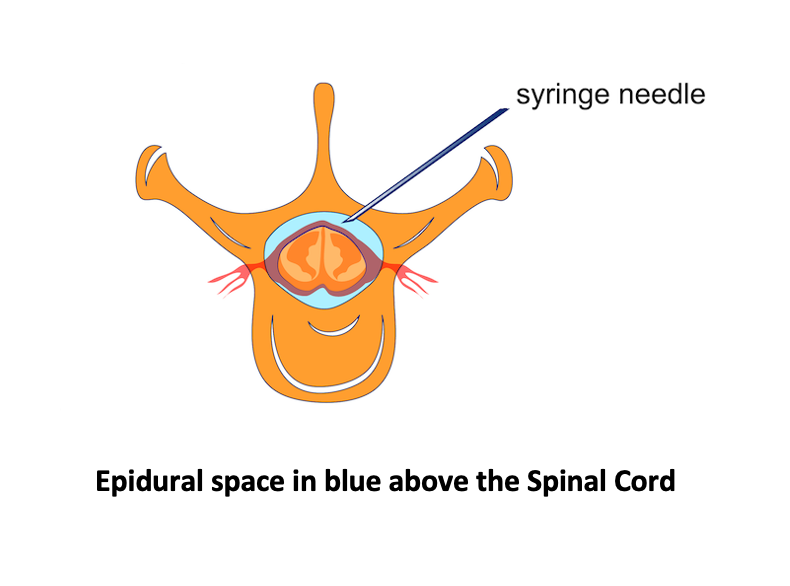
Cervical Epidural steroid injections are cortisone steroid injections and should be given by a Consultant Spine Surgeon who will have the necessary skill and expertise in this area.
These injections are given in the epidural space that lies above the spinal cord in the spinal canal. These injections are effective for neck pain and arm pain on both sides as it covers a wider area of your spine. There is instant relief for neck and arm pain.
Cervical Nerve Root steroid injections
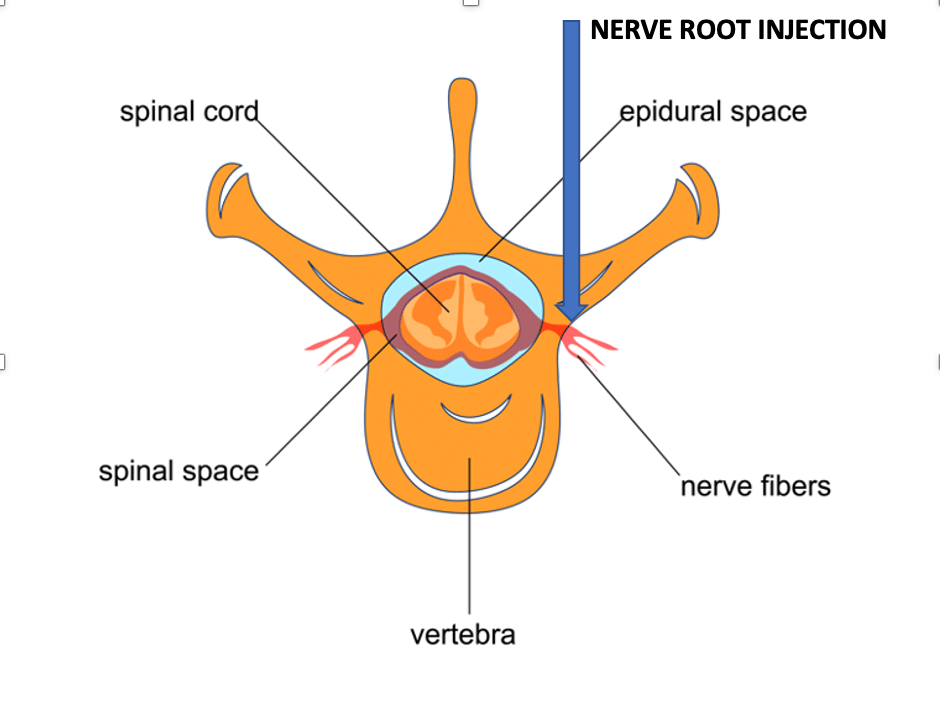
Cervical Nerve root injections are given when the spinal nerve is trapped or pinched by a prolapsed or herniated disc. These steroid injections are given around the trapped or pinched nerve to help reduce nerve root inflammation.
Spinal steroid injections contain a small mixture of cortisone (steroid) and a numbing solution (local anaesthetic) and are given under sedation. You will not feel any pain during this cortisone shot and there will be instant relief from neck and arm pain after you wake up from the sedation.
When should you consider neck surgery for Cervical Radiculopathy?
Anterior Cervical Discectomy and Fusion (ACDF)
Anterior Cervical Discectomy and Fusion (ACDF) is considered for Neck surgery for a pinched nerve in Cervical Radiculopathy when all the above methods of management are not able to give relief from neck and arm pain.
In ACDF the prolapsed disc is removed through a small incision in front of the neck and the pinched nerve is carefully released. The disc space is filled with a metal cage and most patients go home the following day.
What happens if Cervical Radiculopathy is left untreated?
If Cervical Radiculopathy is left untreated, the prolonged pressure on the pinched nerve will cause permanent damage to the nerve. The symptoms usually start with pain from the neck that travels along your arm and will gradually progress to tingling and numbness in your arm. Initially the tingling and numbness will come and go but later, as time goes by, the numbness may become permanent and you will not be able to feel or appreciate what you hold in your hand.
When it gets to a situation that we cannot feel what you hold in our hands, we tend to lose grip and drop them. Simple activities of daily living like driving, putting on your clothes, washing yourself and eating will become extremely difficult.
Cervical radiculopathy if left untreated can lead to cervical stenosis where the spinal canal that contains the spinal-cord coming from the brain is blocked. Cervical Stenosis causes difficulty in walking, loss of balance and performing activities that require coordination of your hands like combing your hair, washing your face, dressing up, and cooking your meals.
What kind of doctor do I see for Cervical Radiculopathy?
Cervical radiculopathy is usually suspected or diagnosed by your primary care physician or a general practitioner from your symptoms and presentation. The practitioner arranges an MRI scan that will show the location, extent and severity of Cervical radiculopathy. MRI scans are very useful in showing the soft tissue detail on the spinal nerve impingement from a cervical disc prolapse, foraminal stenosis or cervical canal stenosis.
Cervical radiculopathy must be treated by a spinal surgeon after advanced training in orthopaedic surgery or neurosurgery. In London, Cervical radiculopathy is treated by Consultant spinal surgeon or neurosurgeon.
